Failure in Confined Brazilian Tests on Sandstone
Abstract
1. Introduction
2. Materials and Methods
2.1. Experimental Methods
2.2. Numerical Methods
3. Results
3.1. Experimental Results
3.2. Post-Failure Observations of Samples
3.3. Numerical Results
4. Conclusions
Author Contributions
Funding
Institutional Review Board Statement
Informed Consent Statement
Data Availability Statement
Conflicts of Interest
References
- Ramsey, J.M.; Chester, F.M. Hybrid Fracture and the Transition from Extension Fracture to Shear Fracture. Nature 2004, 428, 63–66. [Google Scholar] [CrossRef]
- Zhu, Q.Z. A New Rock Strength Criterion from Microcracking Mechanisms Which Provides Theoretical Evidence of Hybrid Failure. Rock Mech. Rock Eng. 2017, 50, 341–352. [Google Scholar] [CrossRef]
- Lan, H. Universal Confined Tensile Strength of Intact Rock. Sci. Rep. 2019, 9, 1–9. [Google Scholar] [CrossRef] [PubMed]
- Patel, S.; Martin, C.D. Application of Flattened Brazilian Test to Investigate Rocks Under Confined Extension. Rock Mech. Rock Eng. 2018, 51, 3719–3736. [Google Scholar] [CrossRef]
- Phueakphum, D.; Fuenkajorn, K.; Walsri, C. Effects of intermediate principal stress on tensile strength of rocks. Int. J. Fract. 2013, 181, 163–175. [Google Scholar] [CrossRef]
- Hoek, E.; Martin, C.D. Fracture Initiation and Propagation in Intact Rock—A Review. J. Rock Mech. Geotech. Eng. 2014, 6, 287–300. [Google Scholar] [CrossRef]
- Perras, M.A.; Diederichs, M.S. A Review of the Tensile Strength of Rock: Concepts and Testing. Geotech. Geol. Eng. 2014, 32, 525–546. [Google Scholar] [CrossRef]
- Hoek, E.; Brown, E. Empirical Strength Criterion for Rock Masses. J. Geotech. Eng. Div. 1980, 106, 1013–1035. [Google Scholar] [CrossRef]
- Labuz, J.F.; Zeng, F.; Makhnenko, R.; Li, Y. Brittle Failure of Rock: A Review and General Linear Criterion. J. Struct. Geol. 2018, 112, 7–28. [Google Scholar] [CrossRef]
- Bobich, J. Experimental Analysis of the Extension to Shear Fracture Transition in Berea Sandstone. Master’s Thesis, Texas A&M University, College Station, TX, USA, 2005. [Google Scholar]
- Brace, W.F. Brittle Failure of Rock. In State of Stress in the Earth’s Crust, 1st ed.; Judd, W.R., Ed.; Elsevier: New York, NY, USA, 1964; pp. 111–180. [Google Scholar]
- Mogi, K. Effect of the Intermediate Principal Stress on Rock Failure. J. Geophys. Res. 1967, 72, 5117–5131. [Google Scholar] [CrossRef]
- Jaeger, J.C.; Hoskins, E.R. Rock Failure under the Confined Brazilian Test. J. Geophys. Res. 1966, 71, 2651–2659. [Google Scholar] [CrossRef]
- Yawei, L.; Ghassemi, A. Rock Failure Behavior and Brittleness under the Confined Brazilian Test. In 52nd U.S. Rock Mechanics/Geomechanics Symposium; American Rock Mechanics Association: Seattle, WA, USA, 2018. [Google Scholar]
- Boyce, S.H.; Rougier, E.; Knight, E.E.; Reda Taha, M.M.; Stormont, J.C. Experimental Study correlating damage and permeability in concrete using confined, flattened Brazilian disks. Int. J. Damage Mech. 2021. [Google Scholar] [CrossRef]
- ASTM D2938. Standard Test Method for Unconfined Compressive Strength of Intact Rock Core Specimens; ASTM International: West Conshohocken, PA, USA, 2010; Available online: www.astm.org (accessed on 7 October 2020).
- ASTM D3967. Standard Test Method for Splitting Tensile Strength of Intact Rock Core Specimens; ASTM International: West Conshohocken, PA, USA, 2010; Available online: www.astm.org (accessed on 6 July 2020).
- Wang, Q.Z.; Jia, X.M.; Kou, S.Q.; Zhang, Z.X.; Lindqvist, P.A. The Flattened Brazilian Disc Specimen Used for Testing Elastic Modulus, Tensile Strength and Fracture Toughness of Brittle Rocks: Analytical and Numerical Results. Int. J. Rock Mech. Min. Sci. 2004, 41, 245–253. [Google Scholar] [CrossRef]
- ASTM C496. Standard Test Method for Splitting Tensile Strength of Cylindrical Concrete Specimens; ASTM International: West Conshohocken, PA, USA, 2010; Available online: www.astm.org (accessed on 6 July 2020).
- Hondros, G. The Evaluation of Poisson’s Ratio and the Modulus of Materials of a Low Tensile Resistance by the Brazilian (Indirect Tensile) Test with Particular Reference to Concrete. Aust. J. Appl. Sci. 1959, 10, 243–268. [Google Scholar]
- Knight, E.E.; Rougier, E.; Lei, Z.; Euser, B.; Chau, S.H.; Boyce, S.H.; Gao, K.; Okubo, K.; Froment, M. HOSS: An Implementation of the Combined Finite-Discrete Element Method. Comput. Part. Mech. 2020, 7, 765–787. [Google Scholar] [CrossRef]
- Munjiza, A. The Combined Finite-Discrete Element Method; John Wiley and Sons: Chichester, UK, 2004. [Google Scholar]
- Munjiza, A.; Knight, E.E.; Rougier, E. Computational Mechanics of Discontinua, 1st ed.; John Wiley and Sons: Chichester, UK, 2012. [Google Scholar]
- Munjiza, A.; Rougier, E.; Knight, E.E. Large Strain Finite Element Method: A Practical Course, 1st ed.; John Wiley and Sons: Chichester, UK, 2015. [Google Scholar]
- Rougier, E.; Knight, E.E.; Broome, S.T.; Sussman, A.J.; Munjiza, A. Validation of a Three-Dimensional Finite-Discrete Element Method Using Experimental Results of the Split Hopkinson Pressure Bar Test. Int. J. Rock Mech. Min. Sci. 2014, 70, 101–108. [Google Scholar] [CrossRef]
- Euser, B.; Rougier, E.; Lei, Z.; Knight, E.E.; Frash, L.; Carey, J.W.; Viswanathan, H.; Munjiza, A. Simulation of Fracture Coalescence in Granite via the Combined Finite-Discrete Element Method. Rock Mech. Rock Eng. 2019, 52, 3213–3227. [Google Scholar] [CrossRef]
- Chau, V.; Rougier, E.; Lei, Z.; Knight, E.E.; Gao, K.; Hunter, A.; Srinivasan, G.; Viswanathan, H. Numerical Analysis of Flyer Plate Experiments in Granite via the Combined Finite-Discrete Element Method. Comput. Part. Mech. 2020, 7, 1005–1016. [Google Scholar] [CrossRef]
- Boyce, S.H.; Lei, Z.; Euser, B.; Knight, E.E.; Rougier, E.; Stormont, J.C.; Reda Taha, M.M. Simulation of Mixed-Mode Fracture Using the Combined Finite-Discrete Element Method. Comput. Part. Mech. 2020, 7, 1047–1055. [Google Scholar] [CrossRef]
- Erarslan, N.; Williams, D.J. Experimental, Numerical and Analytical Studies on Tensile Strength of Rocks. Int. J. Rock Mech. Min. Sci. 2012, 49, 21–30. [Google Scholar] [CrossRef]
- Song, Z.; Li, M.; Yin, G.; Ranjith, P.; Zhang, D.; Liu, C. Effect of Intermediate Principal Stress on the Strength, Deformation, and Permeability of Sandstone. Energies 2018, 11, 2694. [Google Scholar] [CrossRef]
- Singh, A.; Rao, K.S.; Ayothiraman, R. An Analytical Solution to Wellbore Stability Using Mogi-Coulomb Failure Criterion. J. Rock Mech. Geotech. Eng. 2019, 11, 1211–1230. [Google Scholar] [CrossRef]
- Nicksiar, M. Crack Initiation Stress in Low Porosity Crystalline and Sedimentary Rocks. Eng. Geol. 2013, 154, 64–76. [Google Scholar] [CrossRef]
- Kranz, R.L. Crack growth and development during creep of Barre granite. Int. J. Rock Mech. Min. Sci. 1979, 16, 23–35. [Google Scholar] [CrossRef]
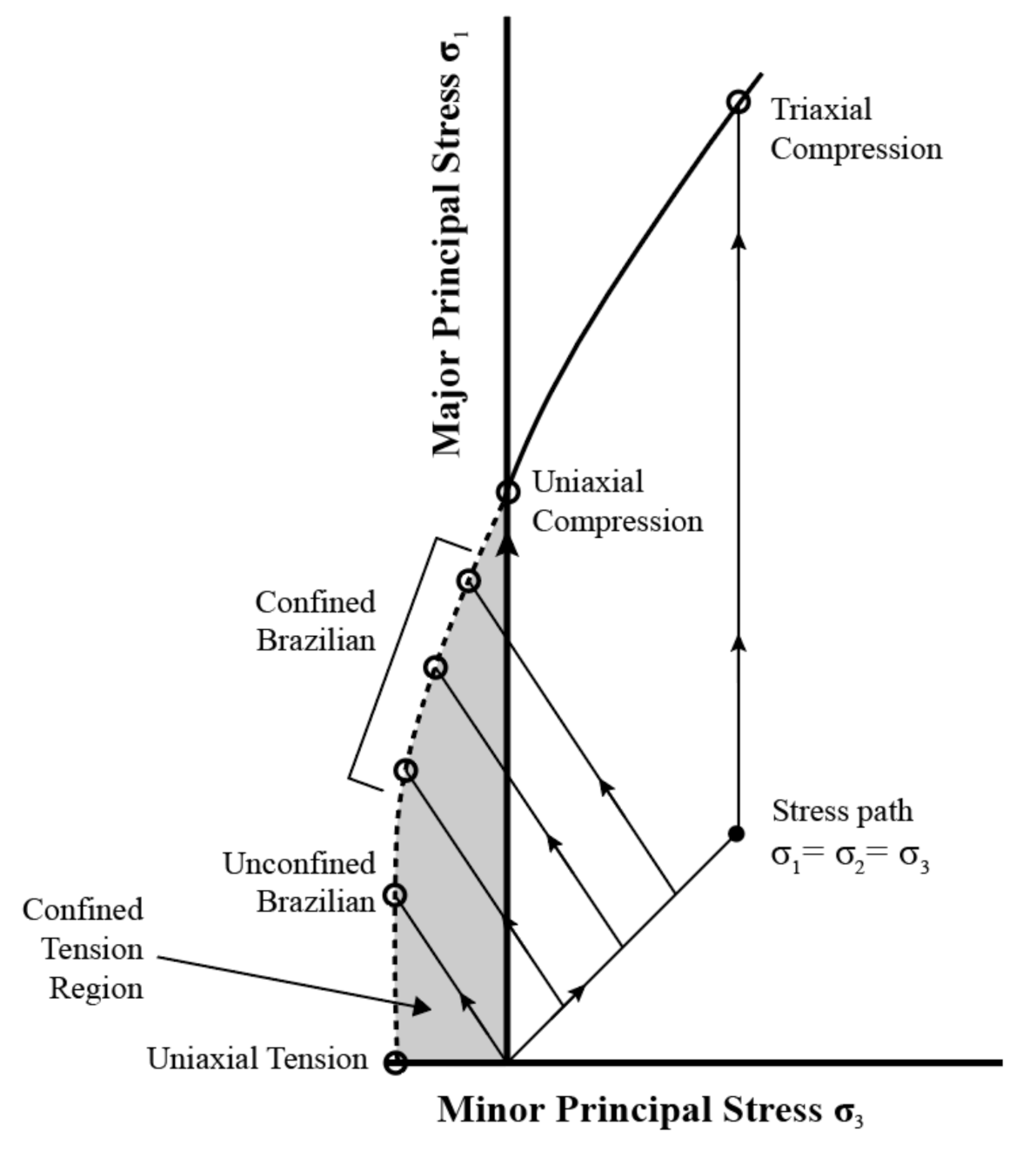
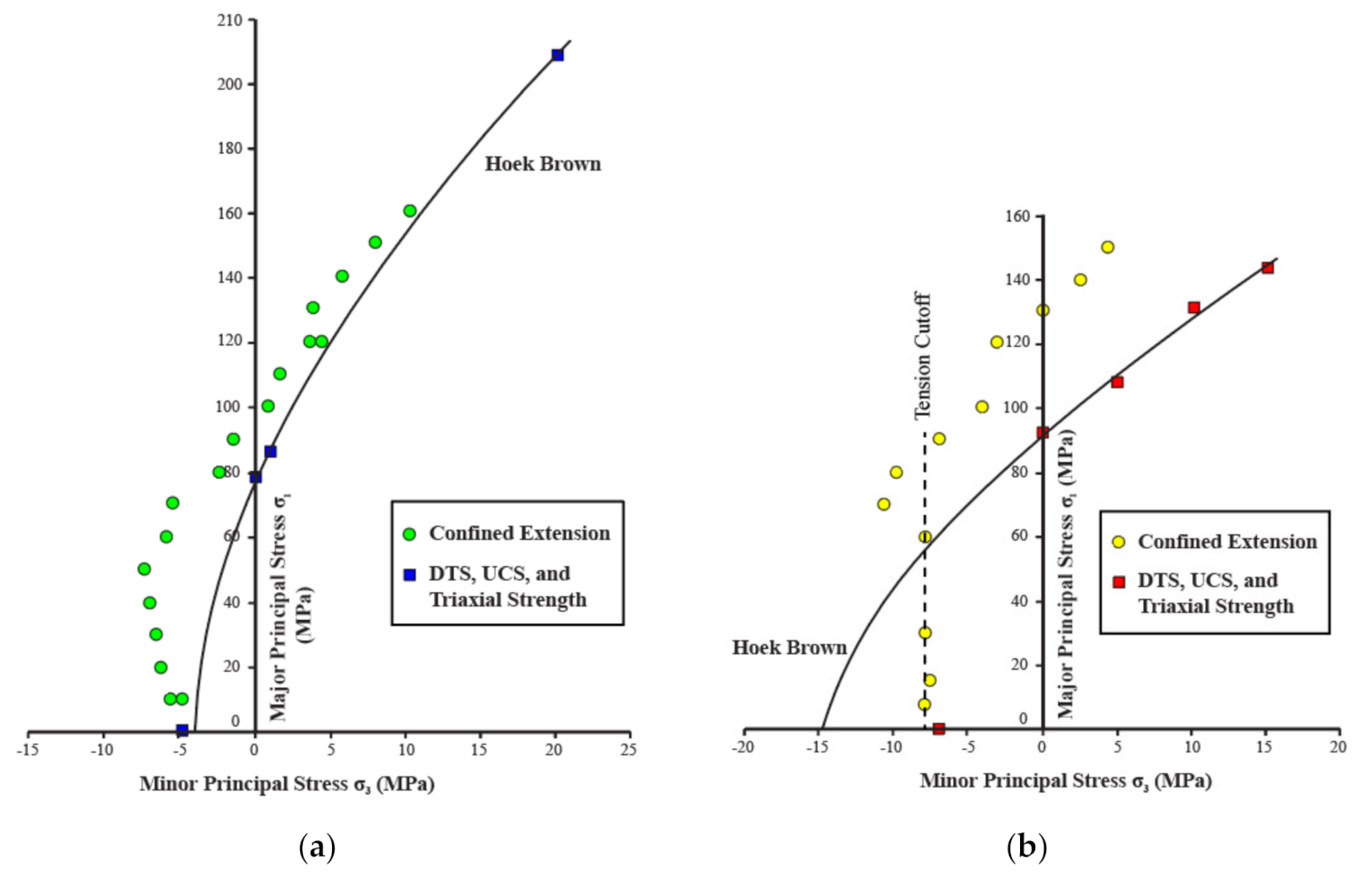
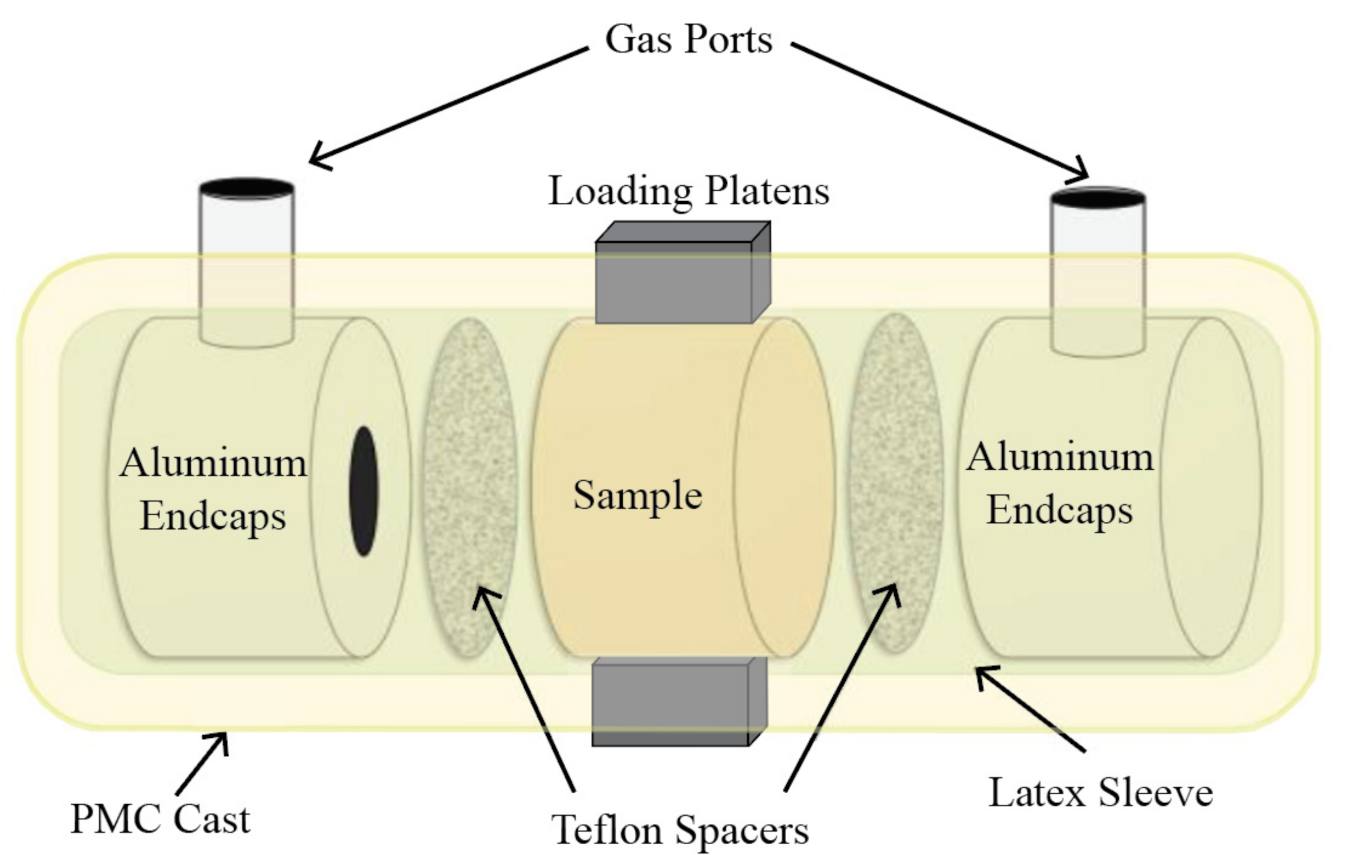
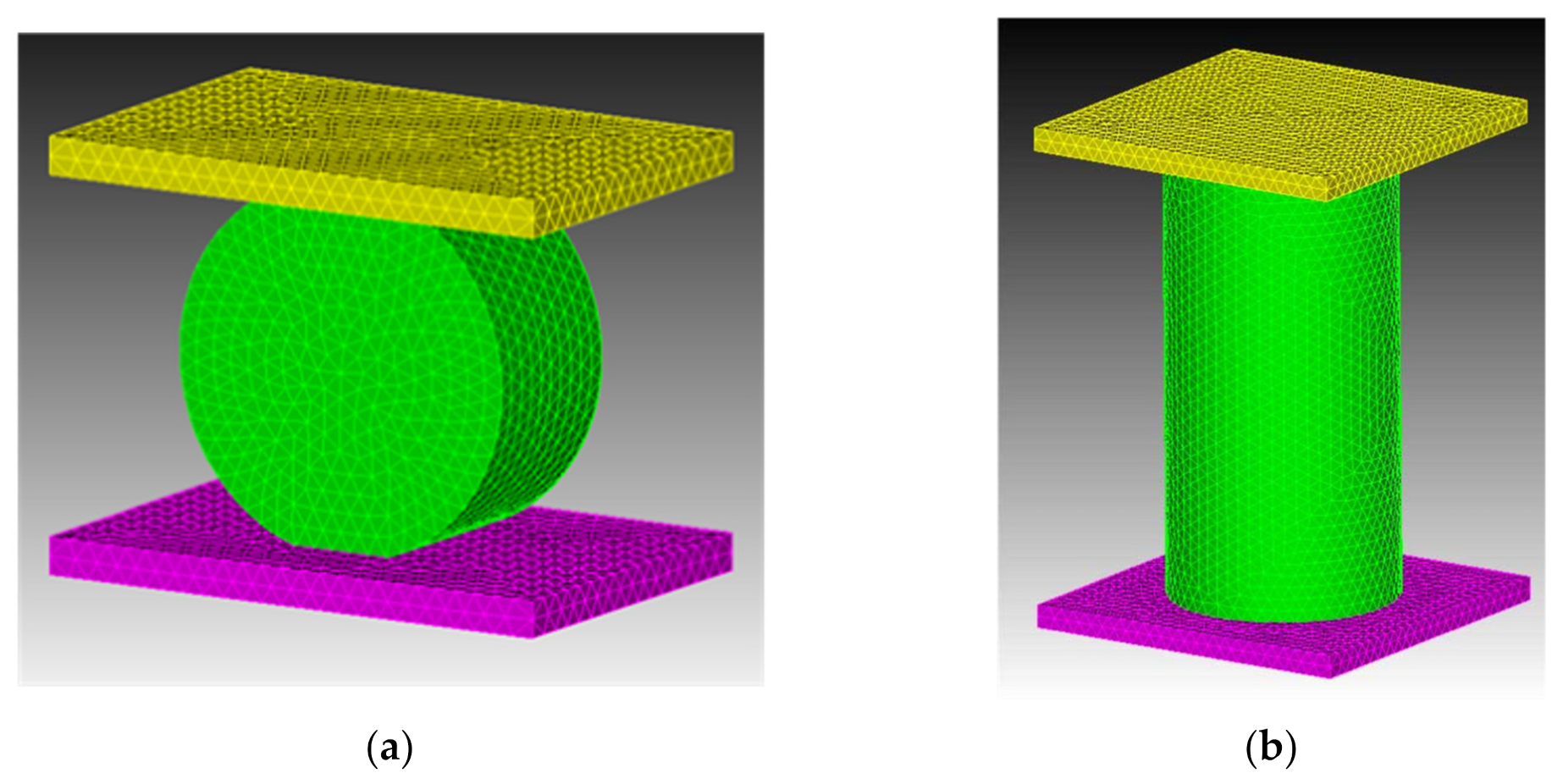
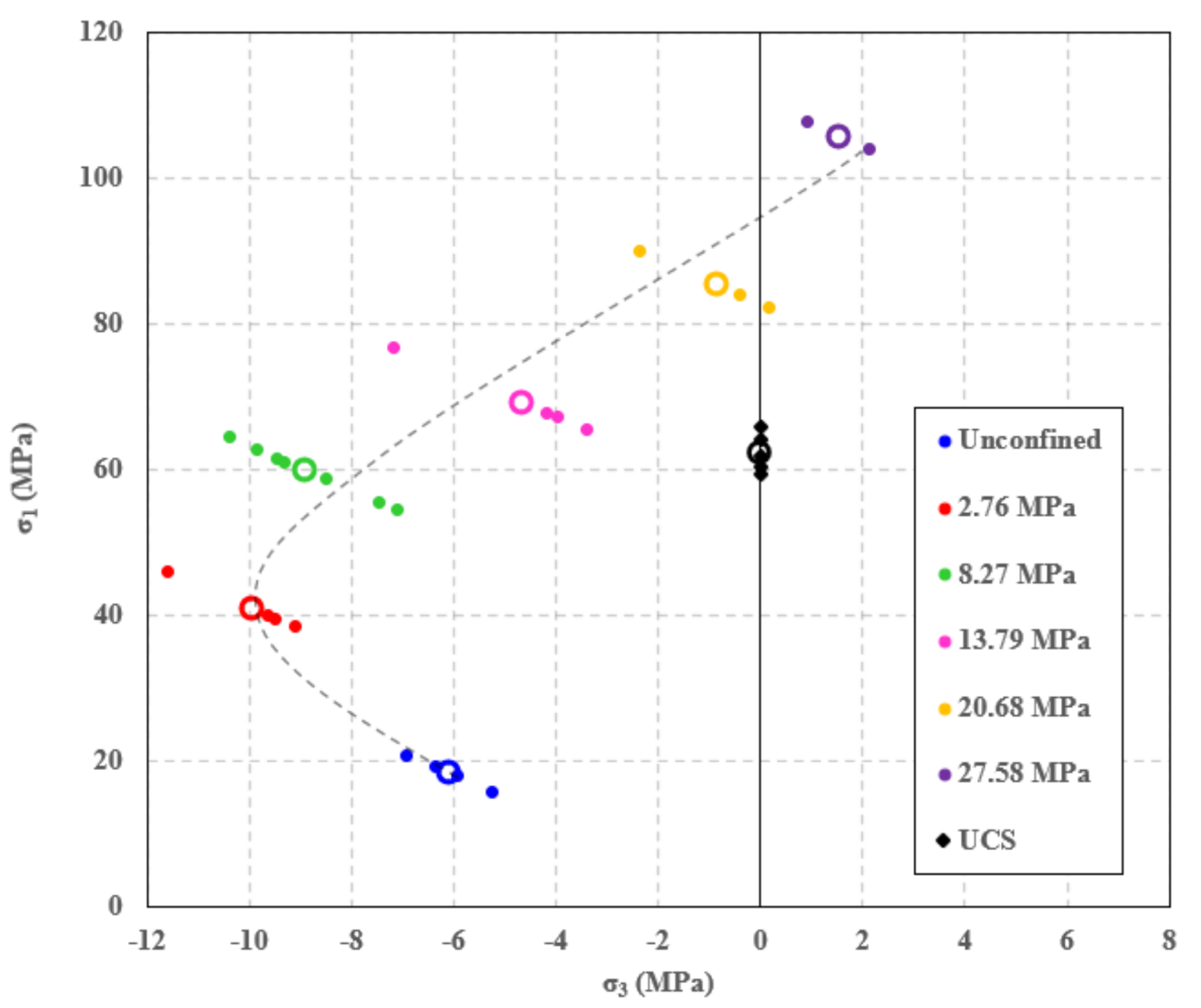
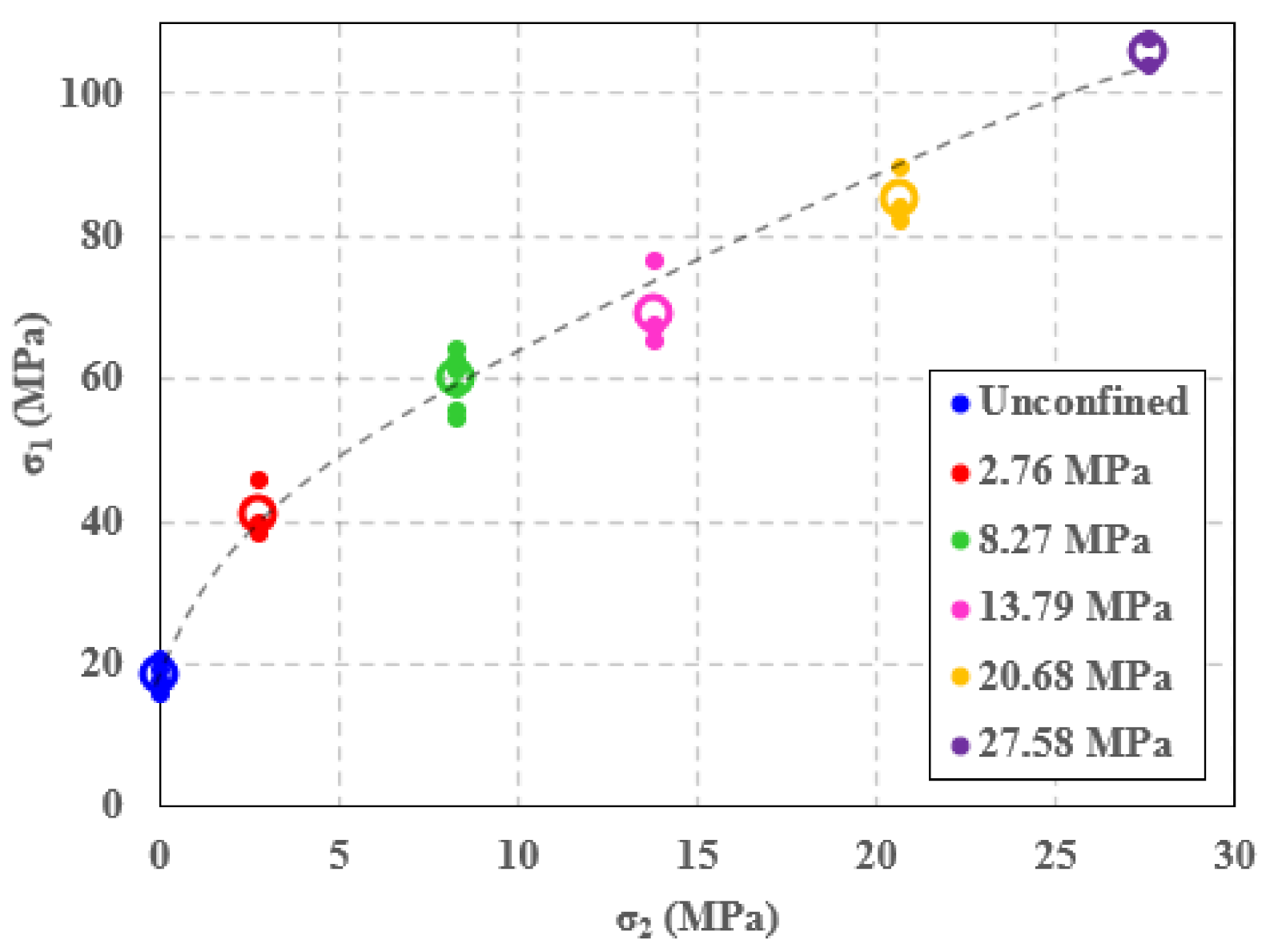
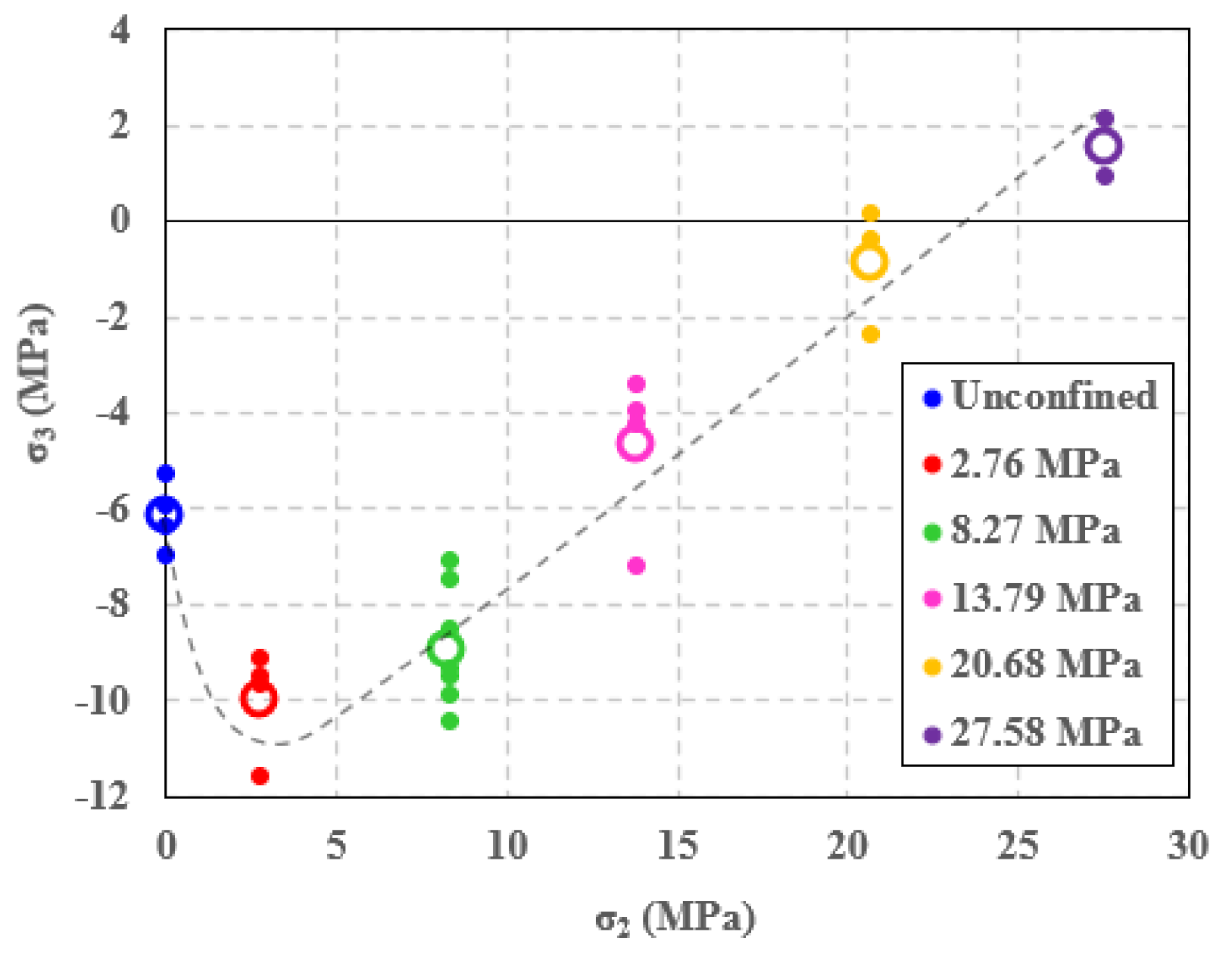
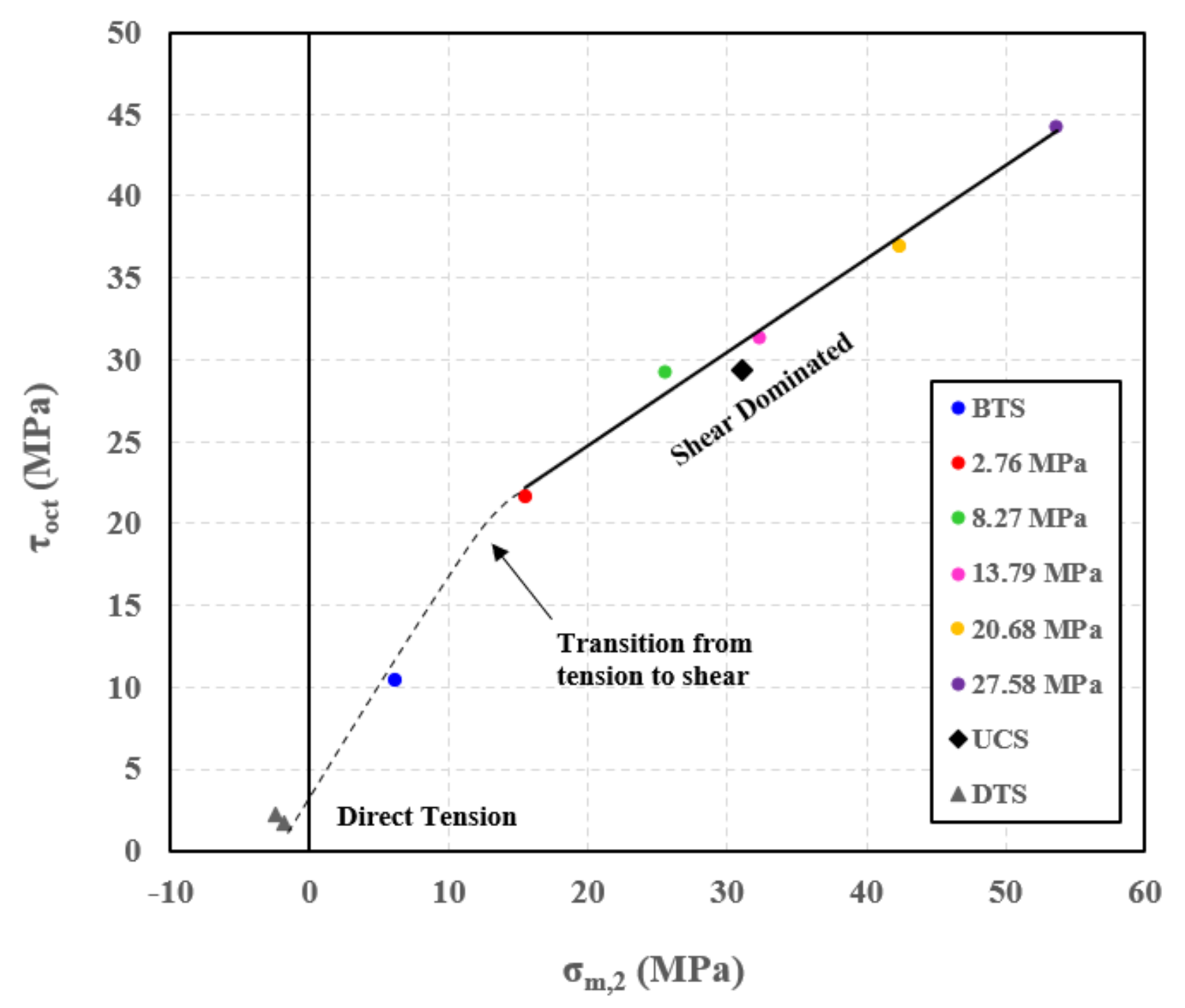
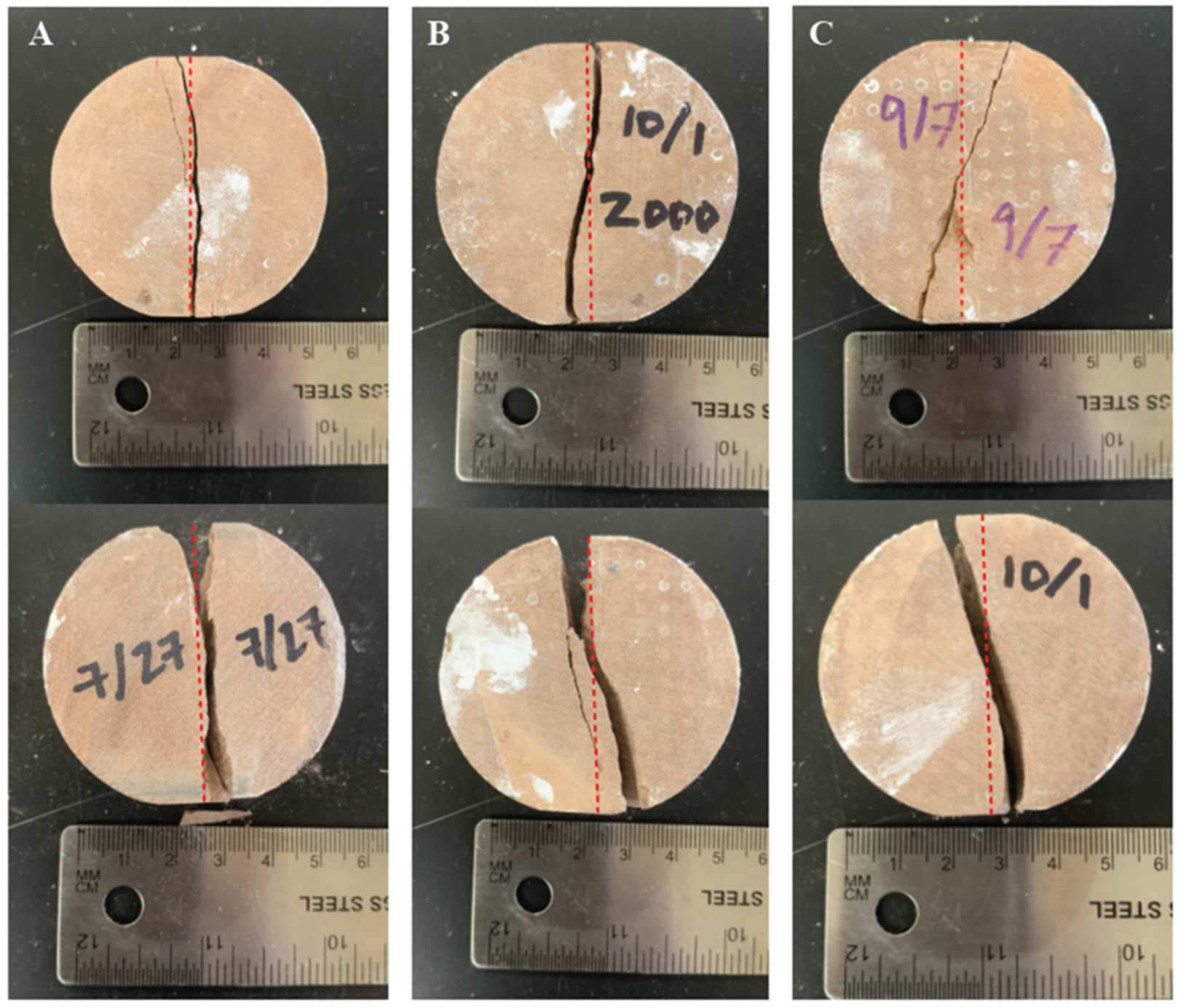

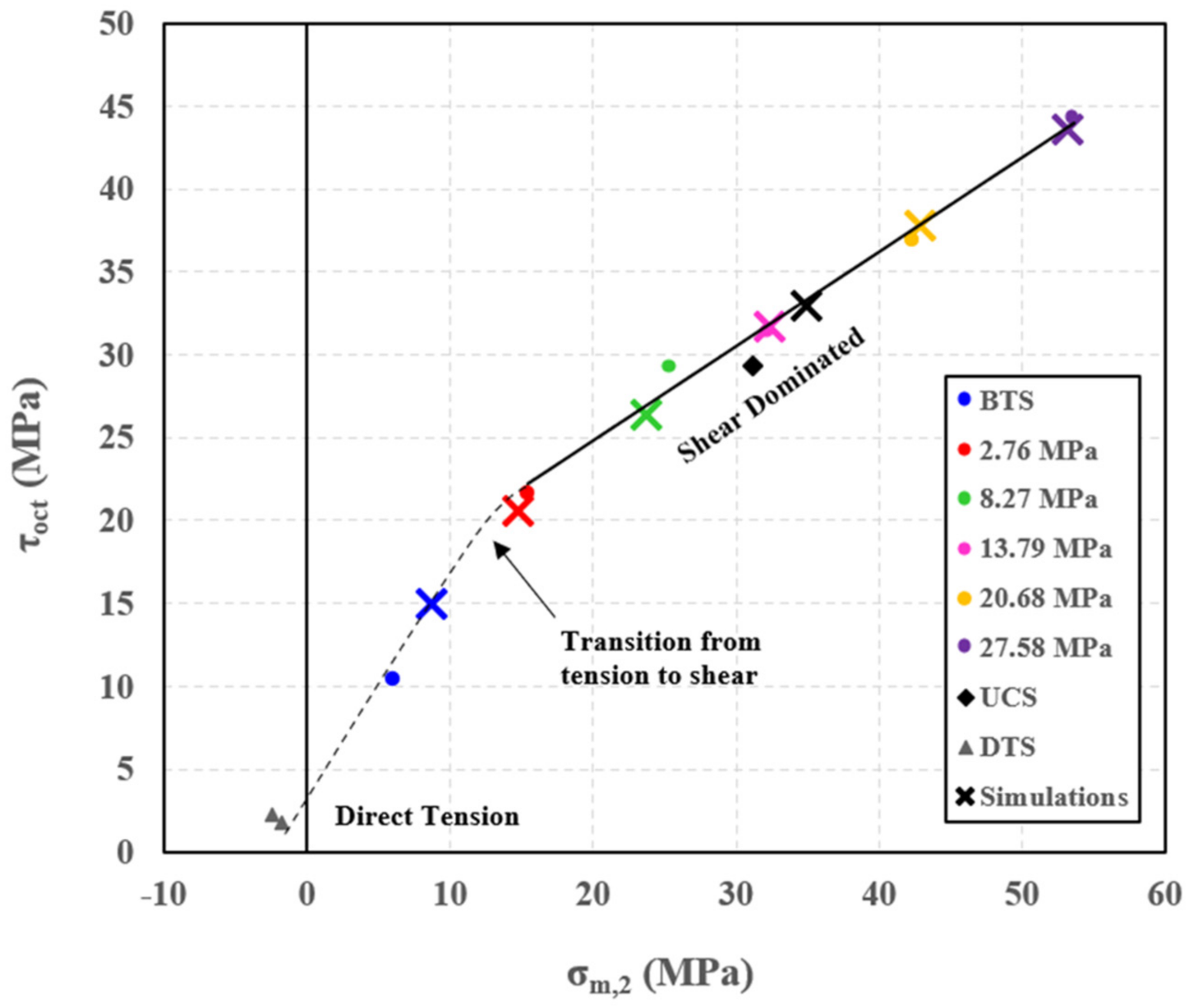
| Young’s Modulus | E (GPa) | 2.74 |
|---|---|---|
| Poisson’s Ratio | ν | 0.20 |
| Density | ρ (kg/m3) | 2483 |
| Tensile Strength | σ (MPa) | 4.69 |
| Shear Strength | τ (MPa) | 30.0 |
| Friction Coefficient: Sandstone/Sandstone | µI | 0.57 |
| Friction Coefficient: Sandstone/Steel | µII | 0.60 |
| Maximum Normal and Shear Displacements | δI, δII (mm) | 0.036, 0.028 |
| Young’s Modulus | E (GPa) | 200 |
|---|---|---|
| Poisson’s Ratio | ν | 0.30 |
| Density | ρ (kg/m3) | 8050 |
Publisher’s Note: MDPI stays neutral with regard to jurisdictional claims in published maps and institutional affiliations. |
© 2021 by the authors. Licensee MDPI, Basel, Switzerland. This article is an open access article distributed under the terms and conditions of the Creative Commons Attribution (CC BY) license (http://creativecommons.org/licenses/by/4.0/).
Share and Cite
Hagengruber, T.; Reda Taha, M.; Rougier, E.; Knight, E.E.; Stormont, J.C. Failure in Confined Brazilian Tests on Sandstone. Appl. Sci. 2021, 11, 2285. https://doi.org/10.3390/app11052285
Hagengruber T, Reda Taha M, Rougier E, Knight EE, Stormont JC. Failure in Confined Brazilian Tests on Sandstone. Applied Sciences. 2021; 11(5):2285. https://doi.org/10.3390/app11052285
Chicago/Turabian StyleHagengruber, Tyler, Mahmoud Reda Taha, Esteban Rougier, Earl E. Knight, and John C. Stormont. 2021. "Failure in Confined Brazilian Tests on Sandstone" Applied Sciences 11, no. 5: 2285. https://doi.org/10.3390/app11052285
APA StyleHagengruber, T., Reda Taha, M., Rougier, E., Knight, E. E., & Stormont, J. C. (2021). Failure in Confined Brazilian Tests on Sandstone. Applied Sciences, 11(5), 2285. https://doi.org/10.3390/app11052285








